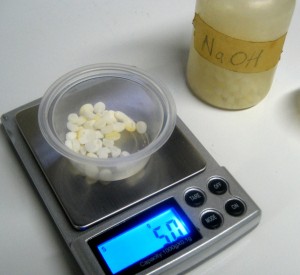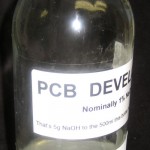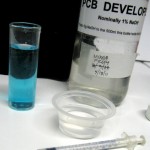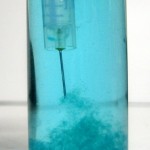When I looked at the jar on 4/17/11, it was just kind of ugly brown, even though it had been on the bubbler for days. I started to look a little closer, making measurements and doing a little math. So much for not wanting a chemistry project 🙂
I dug out an old automotive hydrometer and extrapolating a little beyond its 1.300 max reading, it looks like the bath’s specific gravity is ~1.33. That’s comfortably in the normal working range.
OK – how much of the acid have I used up making CuCl2? Taking the simplified equation 2 HCl + Cu + O -> CuCl2 +H2O and molecular weight of HCl as 36.5, and Cu at wt 63.5, that’s 73 g HCl for every 63.5 g of Cu. I put 86 g of wire in and etched a couple of boards for maybe another gram. So, (87/63.5) *73 = 100 g of HCl.
How much was in there? The acid is just about 10M, so that’s 10*36.5 g HCl per liter. The initial batch was 8 fl 0z of acid (238 ml) and I added another 130 ml later, for a total of 368 ml of acid. That gives 0.368 l * 365g/l= 134 g HCl. So I’ve used up most, but not all of it. If I have 34 g left, my bath – which is now about 380 ml (using a duplicate of the jar, noting the level and measuring water from the 2nd jar filled to that level), that’s about 34/.38= 89 g/l. Dividing by 36.5 g/mole, that should be about 2.45M – which again is comfortably in the usable range.
Looking at the stuff today, it looks greener – though still very dark. Using the drop-on-a-white-surface test, it still looks like > 10g/l Cu+1. Not sure why, unless the bubbler just isn’t done oxidizing the Cu+1 to Cu+2 yet. Or I’ve made some other mistake 🙂
One sobering thing is the tank volume in Seychell’s chart: It says you need about 0.016 l of fresh etchant per cm² of 1oz copper clad board at 50% etch before regeneration. The latter 2 are just about what I do. So a typical shield at 6cm x 8cm will use 0.76 l of etchant – and that’s more than I have! Don’t know how much it will slow down, or how much bubbling during etching would help. Or whether I just need to strip a bunch more wire and make more etchant. I guess this stuff isn’t quite as ideal as I’d hoped. Or at least my expectations weren’t very appropriate.
Next up is titrating the stuff. Since I happen to need 500ml of 1% NaOH for developer, I’ll start with the 5 g of NaOH that will take and make however much 1M titrant it makes. That would be – at 40 g/l for 1M – 5/40 l, or 125 ml. Since I only need a few ml of that, I’ll dilute whatever is left up to my 500 ml and call it developer. Two birds.
It’s all going into the developer bottle anyway, so I might as well mix it there.
I found a nice 1ml syringe and put just 1ml of etchant into ~25ml hot water. Pretty blue, just like in Seychell’s pictures. The water volume doesn’t matter too much – it’s just the absolute amount of etchant that we’re reacting with.
The process was interesting. The endpoint – slightly cloudy despite swirling the syringe around – was pretty obvious. And the answer is: 1.45M. So the math above was only in the ball park, but not very close.
So – what do I need to do? 1.45M is OK, but I’ll shoot for higher on the charts. The higher I go the lower the Cu+2 concentration for whatever copper is there now, so let’s not overdo. I’ll shoot for 3M. From Seychell’s acid control section, starting with 0.38L, final concentration 3M, initial concentration 1.45M and using 10M acid, I get 0.38*(3-1.45)/(10-3)=0.084l. So I’ve added 84 ml of fresh acid – and I’ll let it bubble on. No, I’m not going to titrate it again. But I did do the drop test again and it was more green and less brown – between 1 and 4 g/l – but still far from the clear green we’re looking for. I’ll check back in a couple of days.
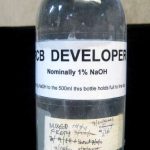 Update 8/9/16: Not that this is the best place for it, but… I needed to make some more developer today. The quantities indicated on the label were most welcome. Unfortunately, the bottle had some significant white deposits inside that didn’t rinse out. I tried some boric acid and that helped, but didn’t do the whole job. Then I used maybe 25ml of very approximately 3M HCl. (A few pipette tips from the 30M jug into some water in the bottle – very much seat of the pants.) Sorry for no pics of the bottle. With a few tens of minutes, that worked quite well. Bottle is full again and looks nice again.
Update 8/9/16: Not that this is the best place for it, but… I needed to make some more developer today. The quantities indicated on the label were most welcome. Unfortunately, the bottle had some significant white deposits inside that didn’t rinse out. I tried some boric acid and that helped, but didn’t do the whole job. Then I used maybe 25ml of very approximately 3M HCl. (A few pipette tips from the 30M jug into some water in the bottle – very much seat of the pants.) Sorry for no pics of the bottle. With a few tens of minutes, that worked quite well. Bottle is full again and looks nice again.

